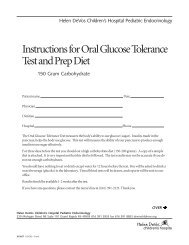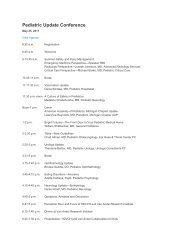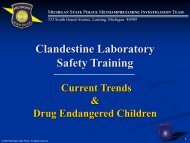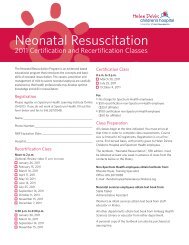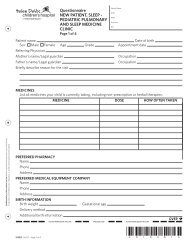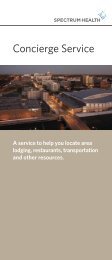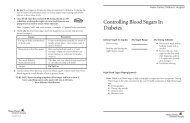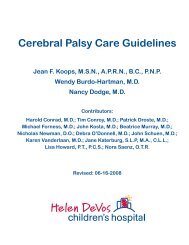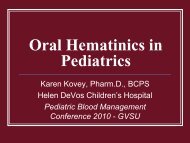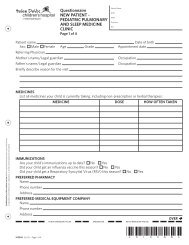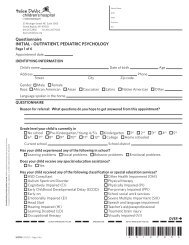T&A - New Guidelines - Helen DeVos Children's Hospital
T&A - New Guidelines - Helen DeVos Children's Hospital
T&A - New Guidelines - Helen DeVos Children's Hospital
Create successful ePaper yourself
Turn your PDF publications into a flip-book with our unique Google optimized e-Paper software.
5/27/2011T&A - <strong>New</strong> <strong>Guidelines</strong>Chad Afman, MDPediatric OtolaryngologistHDVCH Pediatric Update ConferenceMay 25, 2011PPT Demonstration_CA_050508 1
5/27/2011DisclosureDoes not have any relevant financial relationships – no onewith control of the content for this program has any relevantfinancial relationships.ObjectivesOutline the new guidelines for tonsillectomy (released in Jan2011 by the AAO-HNS)Discuss which children should have their tonsillectomyperformed at a children’s hospitalDisclosure: No conflicts of interest to report3PPT Demonstration_CA_050508 2
5/27/2011What is tonsillectomy and why is it important?Third most common surgery performed in the United States.(530,000 per year)Until now, no evidence based national guidelinesexisted to help guide carePresident Obama highlighted tonsillectomy in a Sept 2009address on healthcare reformTwo most common indications:■ Chronic/Recurrent tonsillitis■ Sleep Disordered Breathing (SDB)When performed in properly selected children, tonsillectomy:■ Can reduce throat infections, doctor visits, missed schooldays, and antibiotic use■ Can improve QOL, daytime functioning, and ability to sleepsoundlySummer of 2009PPT Demonstration_CA_050508 3
5/27/2011ResponseScope and Purpose of the GuidelineCreated by a multidisciplinary panel229 papers referenced30 page EBM document designed to:■ Identify children who are the best candidates fortonsillectomy (and those who are not)■ Optimize perioperative care■ Improve counseling and education of families who areconsidering tonsillectomyPPT Demonstration_CA_050508 4
5/27/2011Panel Recommendations10 newsworthy pointsPanel Recommendations1. Most children with frequent throat infections get better ontheir own; watchful waiting is best for most children withfewer than:■■■7 episodes in the past year5 in the past 2 years3 in the past 3 yearsParadise JL, Bluestone CD, Bachman RZ, et al. Efficacy of tonsillectomy forrecurrent throat infections in severely affected children. Results of parallelrandomized and nonrandomized clinical trials. N. Engl. J. Med. 1984. 310(10): 674-83.PPT Demonstration_CA_050508 5
5/27/2011Panel RecommendationsPanel Recommendations2. Severe throat infections are sore throats with 1 or more ofthe following:■ Fever >101■■■Cervical adenopathyTonsillar exudateGABHS positive3. Tonsillectomy can improve QOL when recurrent tonsillitisequals or exceeds:■■■7 episodes in the past year5 in the past 2 years3 in the past 3 yearsPPT Demonstration_CA_050508 6
5/27/2011Panel Recommendations4. Children with less frequent of severe throat infections maystill benefit from Tonsillectomy if:■■■Antibiotic allergy/IntoleranceHistory of PTAPFAPA(What about children with features of SDB and ChronicTonsillitis?)Panel Recommendations5. Large tonsils can obstruct breathing at night causingSleep-Disordered Breathing.SDB is a spectrumSnoring OSA■■■■■AwakeningsMouth breathingPausesApneaRestless sleep■ Excessive sleepiness■ Inattention■ Poor concentration■ HyperactivityVarying degrees of hypoxemia and hypercapnea due todecreased alveolar hypoventilationPPT Demonstration_CA_050508 7
5/27/2011Panel RecommendationsPanel Recommendations6. Primary Care Physicians act as important gate-keepers andshould ask parents of children with SDB and large tonsilsabout problems that might improve after tonsillectomy.■ Poor sleep■■■■Growth delayPoor school performanceBedwettingBehavioral problems7. Although most children with SDB improve aftertonsillectomy, some children, especially those who areobese or have syndromes affecting the head and neck(Down Syndrome) may require further management.(When, if ever, is the best time to obtain a sleep study?)PPT Demonstration_CA_050508 8
5/27/2011Panel RecommendationsTonsillectomy: Special cases8. A single dose of IV dexamethasone during tonsillectomyreduces pain, nausea, and vomiting after surgery.9. Routine use of post-operative antibiotics should not beprescribed (no studies have shown consistent benefits andthere are associated risks, side effects, and cost).10. Parents should be educated about the importance ofmanaging pain and oral intake after tonsillectomy.Sometimes families drive past many otherotolaryngologist to come to a provider inGrand Rapids.When is this appropriate?What does HDVCH provide?■■■■■Pediatric otolaryngologistsPICUPediatric anesthesiologistsPediatric nursesSpecialty service supportPPT Demonstration_CA_050508 9
5/27/2011Most Tonsillectomies are outpatient proceduresWhen to refer to an inpatient pediatric facilityAny child who is >3yo and otherwise healthy with basic careavailable:-Adult in the home who has transportation, can followpost-op instructions, and speak English-telephone-live within in 30 min of an ED-No post operative complicationsExample: 4yo with well controlled asthmaAny child who has a high probability of needing inpatient admission:1. Healthy child less than 3 years old2. Severe OSA (RDI or AHI >20)3. Any child with co-morbiditiesEspecially when involving the head and neck, aerodigestive,circulatory, or neurologic systems■■■■HypotoniaCPNeuromotor DelaysSCD■■■■Down SyndromeCyanotic Heart DiseaseCHARGEDysphagiaPPT Demonstration_CA_050508 10
5/27/2011Which patients need PICU?Children with severe OSA plus:■■■■■■Neurological conditions affecting the airwaySyndromes associated with disproportionate upper airwaysSevere cyanotic congenital heart diseaseMorbid obesityAcute airway obstructionRespiratory failureBlenke EM, Anderson AR, et al. Obstructive sleep apnea adenotonsillectomy inchildren: when to refer to a center with a pediatric intensive care unit? J LaryngolOtol. 2008. (122): 42-5.Which patients need PICU?1. RDI >402. RDI >20 plus on of the following:■ Desats
5/27/2011SummaryCommon surgery with excellent outcomes and large benefits forpatients and families when properly selected.Post-operative care can be widely variable and needs to beanticipated in order to obtain the best outcomes and safety.PPT Demonstration_CA_050508 12




